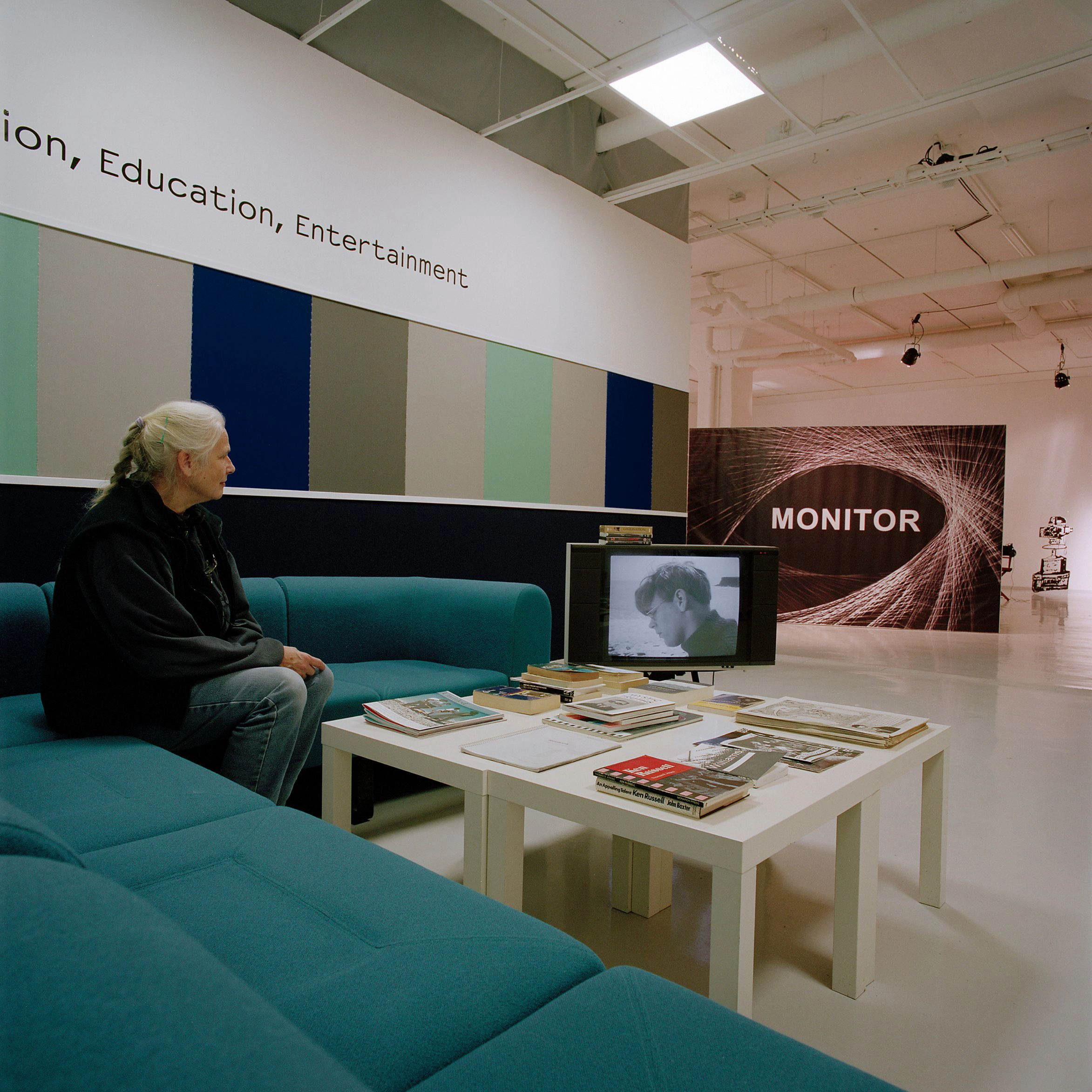
‘Information, Education, Entertainment’, 2007
installation view, Marabouparken, Stockholm
‘Information, Education, Entertainment’, 2007
solo show at Marabouparken, Stockholm, curated by Kim Einarsson
‘Information, Education, Entertainment’ takes its title from the mission statement of the BBC to ‘inform, educate and entertain’. The artworks in the exhibition refer in different ways to Monitor, which ran from 1958 until 1965 and was the first magazine-style arts programme to appear on British television. According to its editor Huw Wheldon, the aim was to provide a cultural education for the masses via the new medium of television, by making ‘the popular good and the good popular’. However, questions arise as to exactly whose culture is considered to be ‘good’ and who decides. Making parallels with the museum, the exhibition explores the idea of public service television as an educational model. Both were, at their inception, created as paternalistic institutions offering a top-down version of culture, and today find themselves under threat, as their public-service ethos disrupts free-market ideology and the commodification of culture underway within the contemporary knowledge economy.
The exhibition begins with a lounge area reminiscent of the lobby of a television station, and also includes two video installations, Monitor (2007) and Ken Russell in Conversation with Olivia Plender (2007), alongside works based on the comic book series The Masterpiece (2001–06).
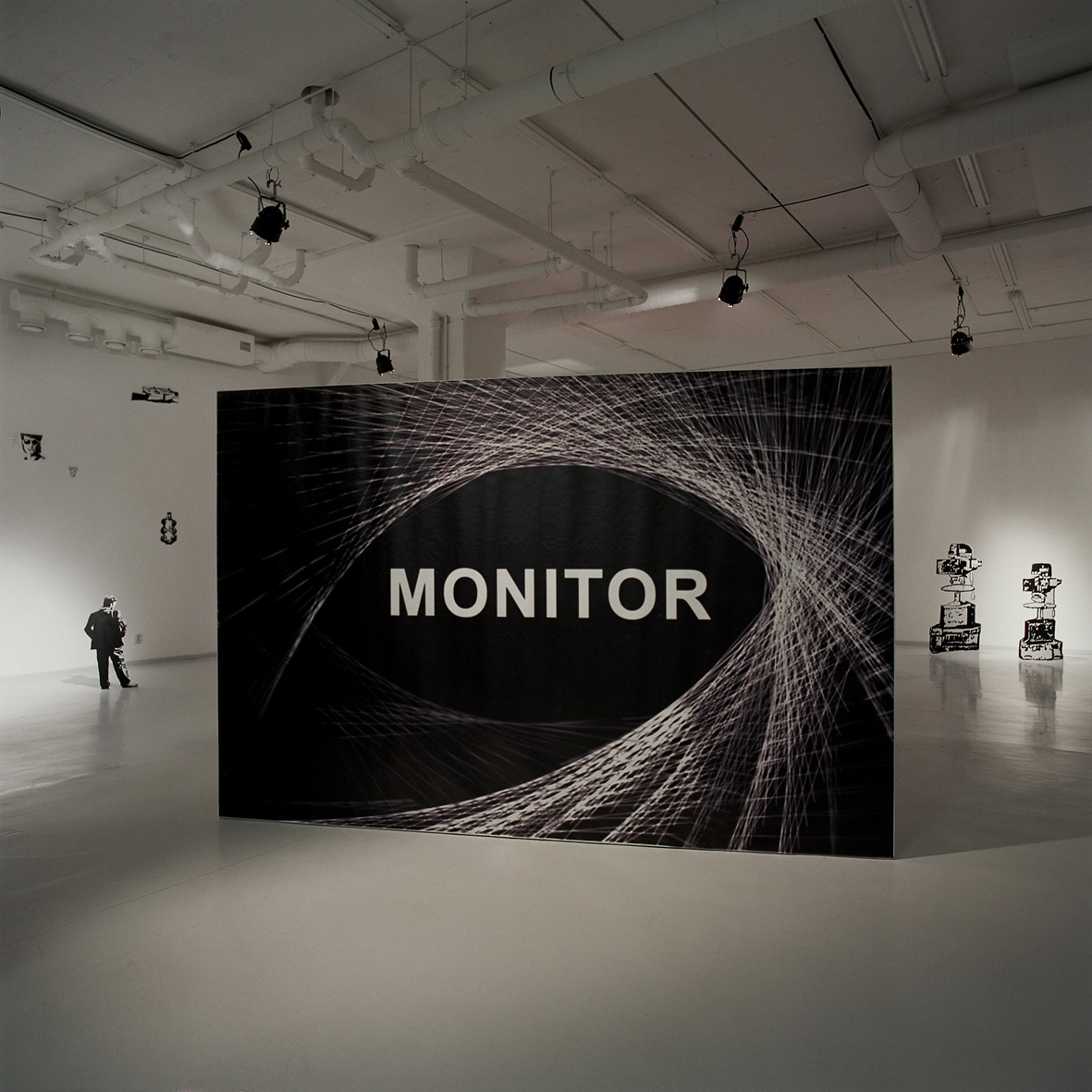
Monitor, 2007, vinyl banner
installation view ‘Information, Education, Entertainment’, Marabouparken, Stockholm
Monitor, 2007
video installation
Monitor reconstructs a documentary, titled Private View, from the television series of the same name, about four young artists living in London. Scenes of their everyday lives are interspersed with a narrator’s descriptions of the London art scene in 1960, when the programme was first broadcast. The tone is that of an anthropologist whose voice is the very embodiment of authority, as he tells us what to think about the art world, while taking us around private views, studios, galleries, museums and into the four artists’ home environments. The video piece, which was first conceived as a performance at Tate Britain in 2006, is accompanied by a sound track with actors reconstructing the original script of the programme.
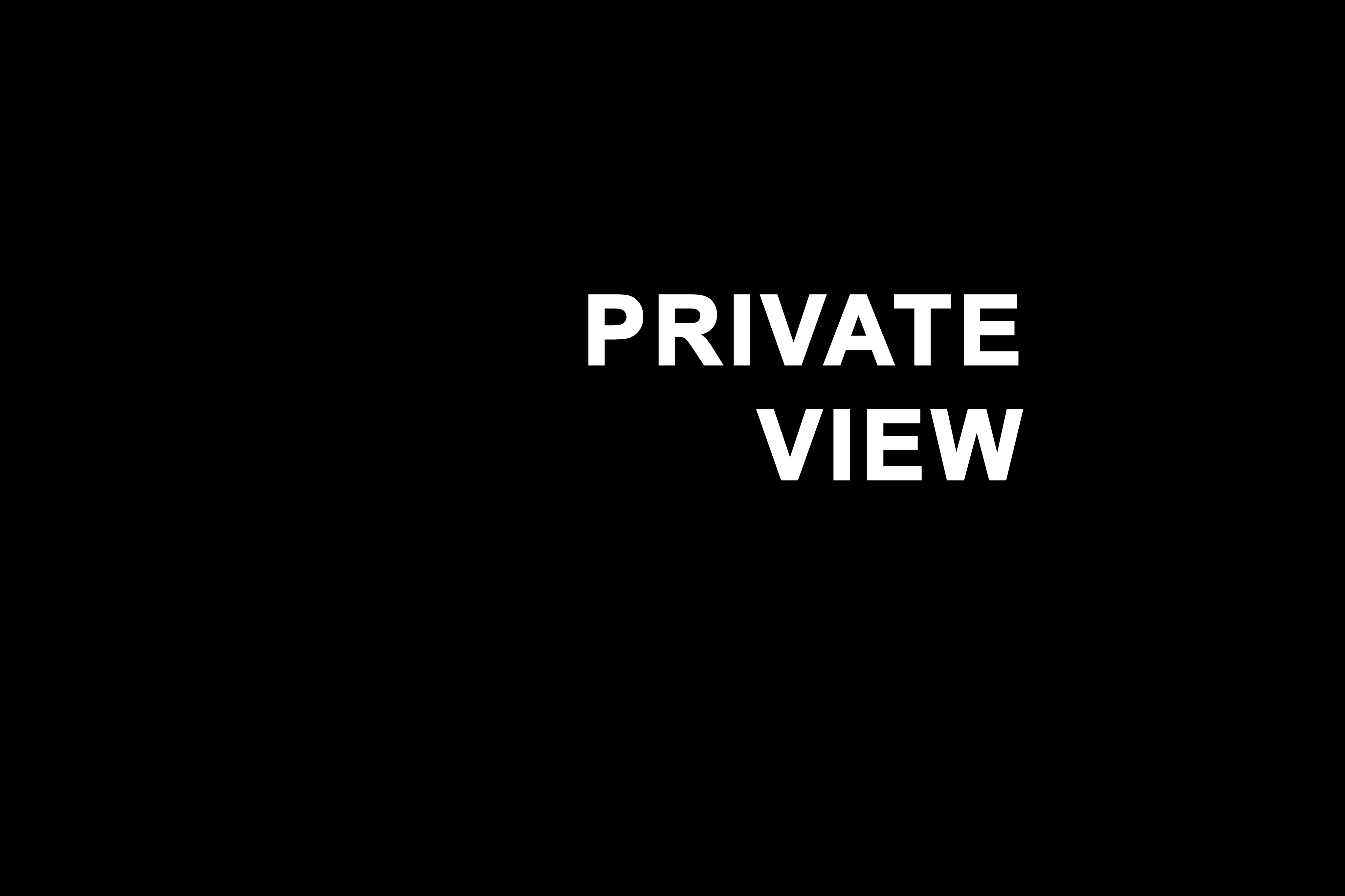
Monitor, 2007
video, 21 min. 29 sec., still
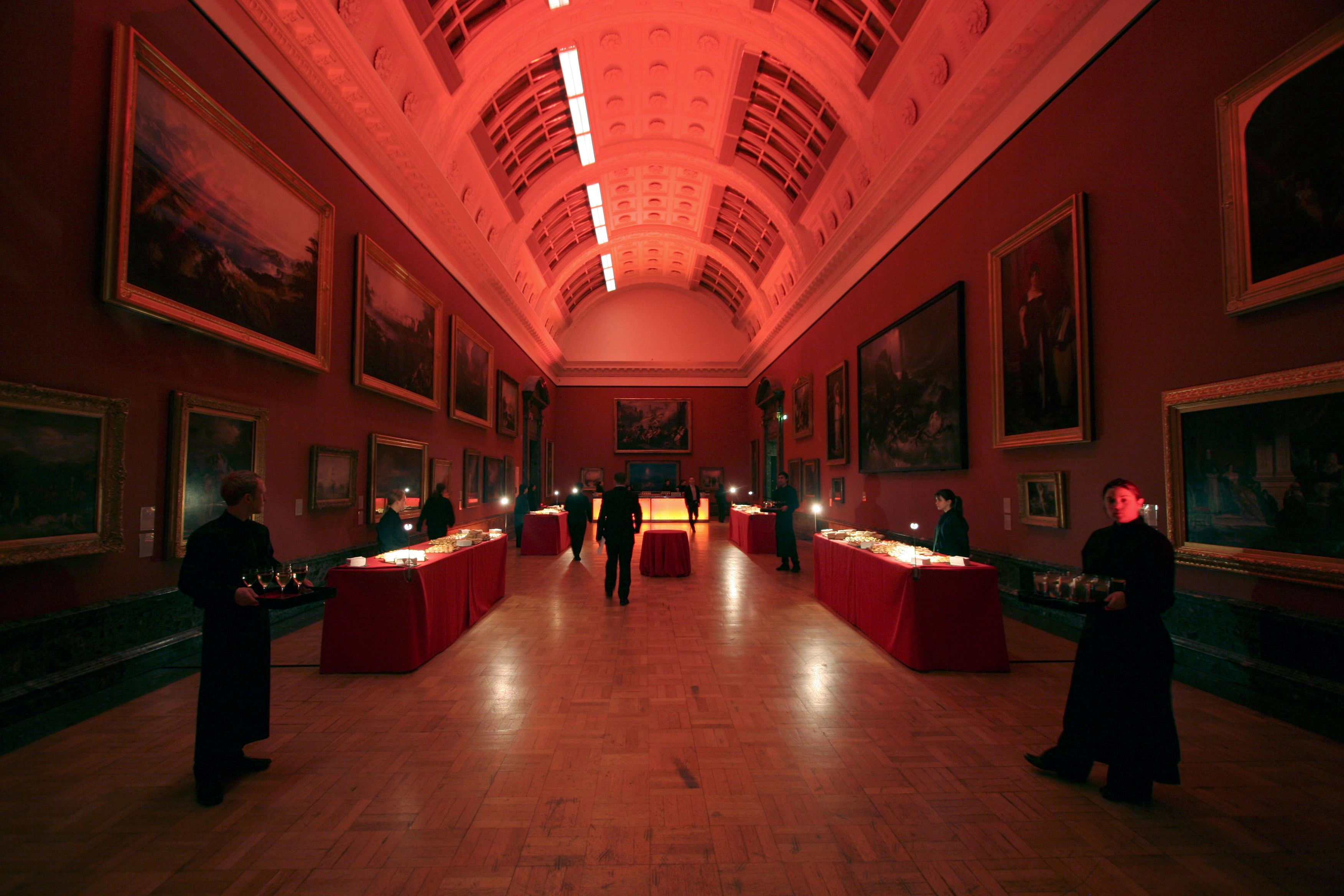
Monitor, 2007
video, 21 min. 29 sec., still
Using photographic slides of the London sites that the audience hears the artists’ voices describe, it is the contemporary city that is depicted in these images – or rather London as it was in 2006, when the piece was made. A deliberate gap opens up, with the aim of creating confusion for the viewer as to what time period is actually being represented. We are shown neighbourhoods such as Notting Hill and Kensington, which are now inhabited by millionaires but were formerly considered bohemian quarters. In their individualistic self-portrayals, the artists represent themselves as society’s ‘outsiders’, however, it is clear with hindsight that lifestyles such as theirs later became a selling point, making the gentrification of a working-class area like Notting Hill possible. Today the programme has an added poignancy, as the artists are framed as if they are poised on the verge of success, but their names are unfamiliar to most of us. By including images of the private view for the Tate Triennial 2006 in the piece, the work also comments on how narratives of success are constructed. Monitor was made into a video for the solo exhibition at Marabouparken.
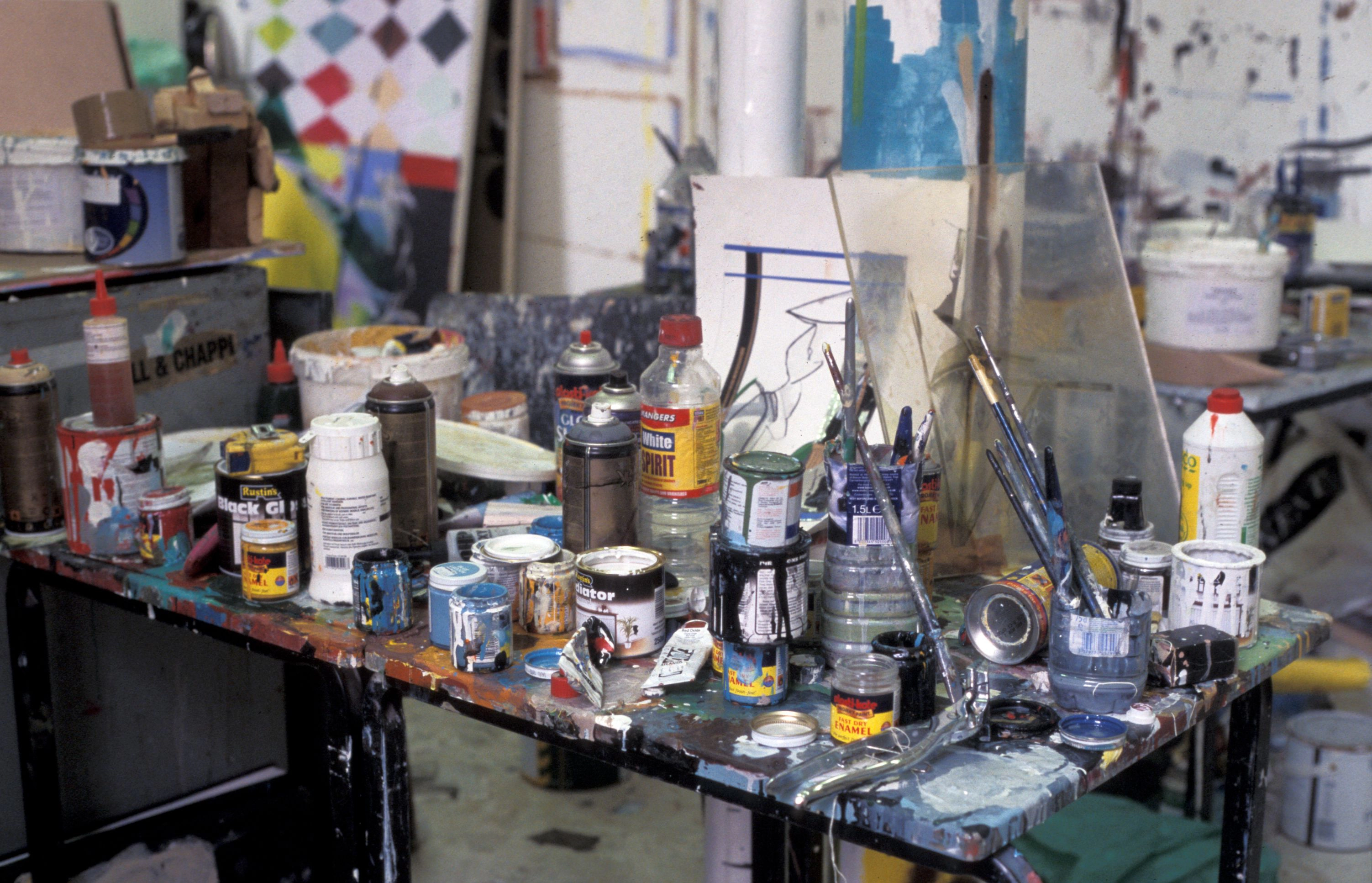
Monitor, 2007
video, 21 min. 29 sec., still

Monitor, 2007
video, 21 min. 29 sec., still

Monitor, 2007
video, 21 min. 29 sec., still
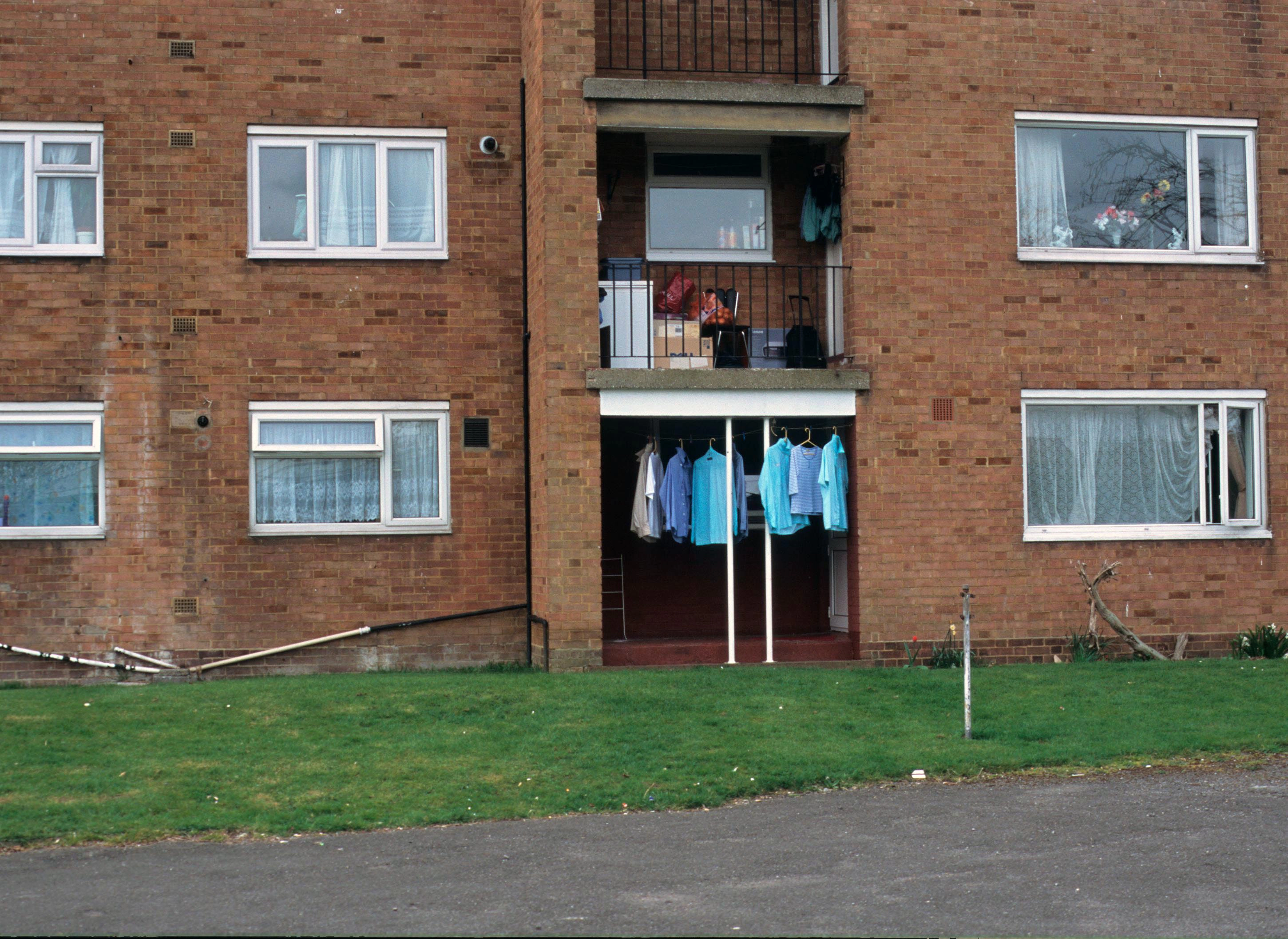
Monitor, 2007
video, 21 min. 29 sec., still
Monitor, 2007
video, 21 min. 29 sec.
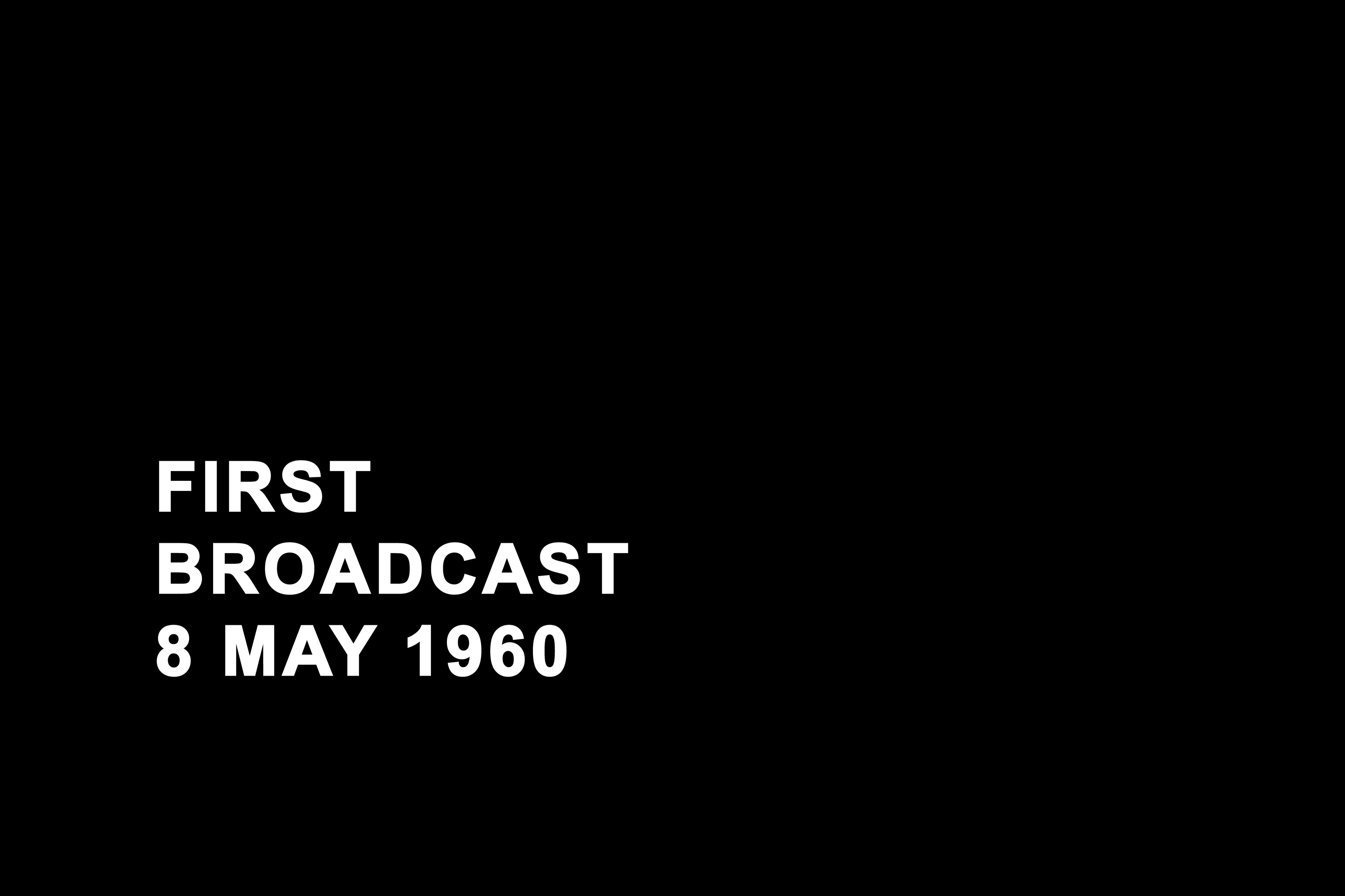
Monitor, 2007
video, 21 min. 29 sec., still
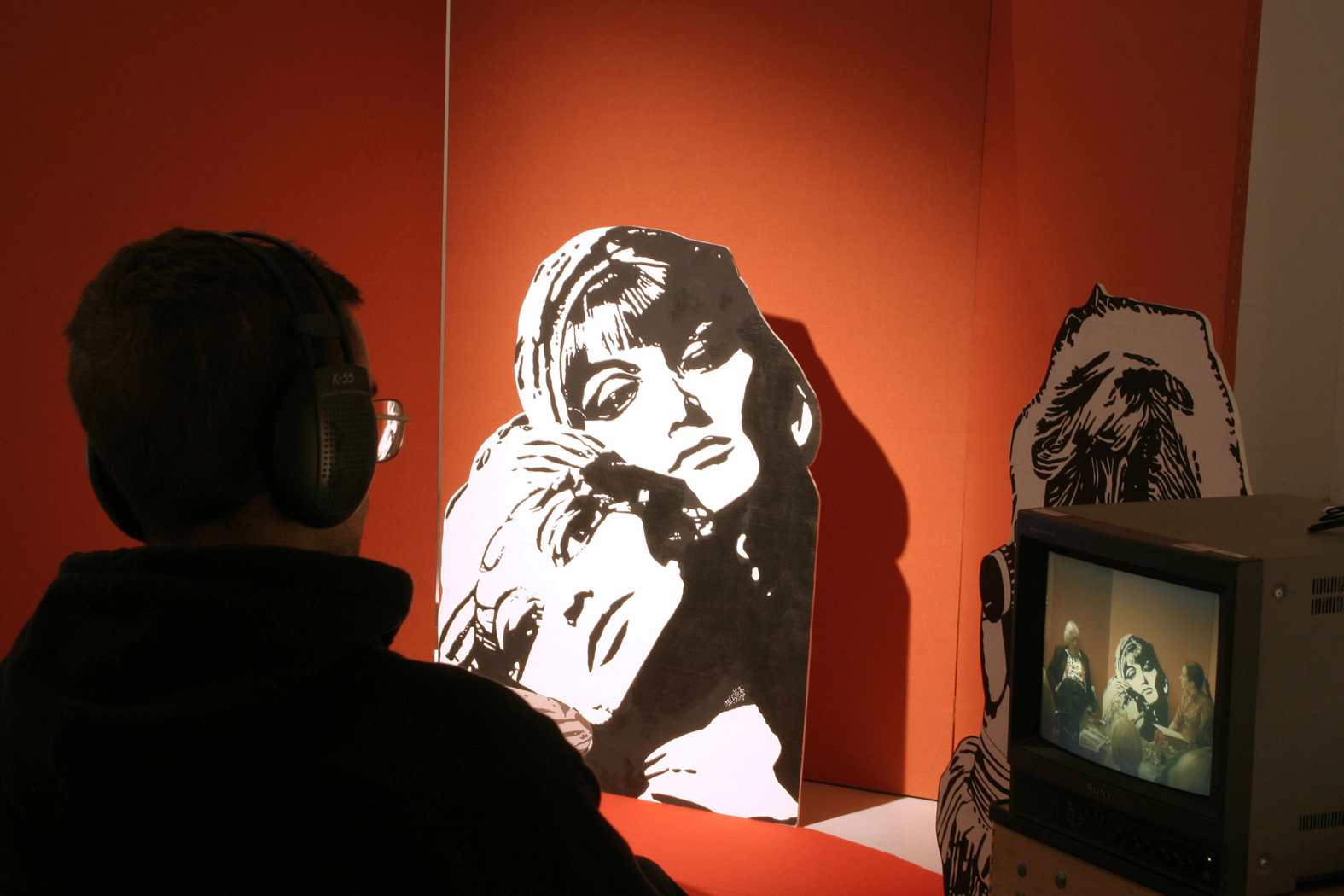
Ken Russell in Conversation with Olivia Plender, 2007
video installation, 25 min. 51 sec., detail
Ken Russell in Conversation with Olivia Plender, 2007
video installation with fabric covered screen, two monitors, seating, carpet, painted MDF cut-out figures
The installation includes video footage of the artist Olivia Plender interviewing the controversial film-maker Ken Russell, in 2005. In the 1960s Ken Russell gained a reputation for the experimental documentaries and biopics about artists that he made for the BBC’s arts programme Monitor, but over the years he moved into making feature films in a variety of styles and genres, including science-fiction and musicals. Several of his works were considered controversial in their time and Ken Russell was represented in the media as the enfant terrible of British cinema. The installation at Marabouparken was made from the set in which the original interview took place and recalls television studios of the 1970s, when Russell was at the height of his fame as a film director. Mimicking the tone of BBC interviews from that time, I attempted to speak with authority as if I were a professional presenter. The audience watches me on a monitor – a young female interviewer performing a role that is traditionally embodied as male – as I wrestled for power over the conversation with the elderly director, who was apparently in his natural habitat.
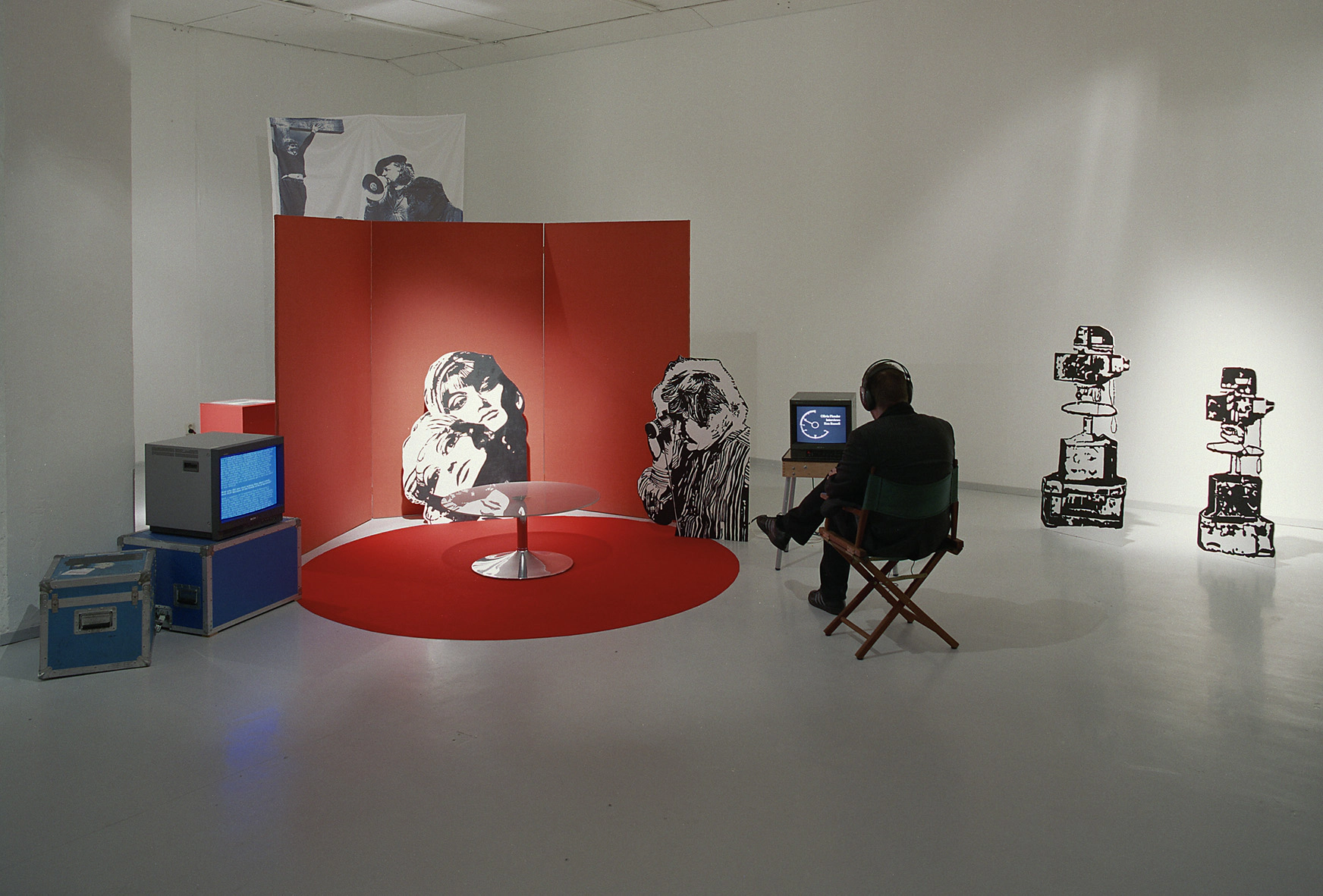
Ken Russell in Conversation with Olivia Plender, 2007
video installation, 25 min. 51 sec., with fabric screen, carpet, furniture, monitors, acrylic paint on MDF cut-outs
Olivia Plender in conversation with Kim Einarsson, on the occasion of the solo exhibition ‘Information, Education, Entertainment’ at Marabouparken, Stockholm, 2007
Kim Einarsson: In almost all of your projects, your starting point is in a specific historic phenomenon and subcultures, for example the Modern Spiritualist Movement, romanticism, and, for this exhibition at Marabouparken a British television show from the 1960s. What would you say is your interest in history?
Olivia Plender: In recent years I have spent a lot of time in libraries and archives. Initially this research related to an interest in romanticism, and specifically a desire to question the outmoded idea that the artist’s role within society is that of the outsider. It is a stereotype that I feel very critical of – in spite of the seductive fantasy of being an inhabitant of bohemia – as it is tied up with a belief in individual (usually masculine) genius. I wanted to know why this particular image of the artist is still so potent within the contemporary world, especially in the media. It’s a product of the early nineteenth-century romantic movement, with Lord Byron being a model for the artist as an exile from polite society, ‘mad, bad and dangerous to know’. I was also interested in how the current notion of ‘genius’ differs from the original. This led me down various parallel historical paths: I have just written a book – a narrative graphic novel called A Stellar Key to the Summerland – based on my research into two alternative social movements from the early twentieth century – the Modern Spiritualist Movement and the Kibbo Kift Kindred. But more recently I have been watching television arts programmes from the 1960s and 1970s. They differ from contemporary arts programmes in a variety of interesting ways, highlighting changes in attitudes to the place of the arts within society, but also to how history is narrated. The 1960s and 1970s type of content-heavy cultural programming was often structured in such a way that it mirrored older forms of communication, such as the lecture format. In addition, there has been a shift in the prevailing sense of what television’s primary function is – from education to entertainment.
In most of my work, particularly the performances and, more recently, museum-style installations, I engage in a certain amount of role playing. My work often contrasts a very didactic position, the voice of an academic historian or an authoritative BBC commentator, for example, with that of the auto-didact, or amateur historian. Because of their vocabulary and mode of presentation they are expected to have a more subjective viewpoint and therefore seem less reliable and potentially related to some non-legitimate, discredited area of study (such as New-Age mysticism). It’s a way of questioning how society produces knowledge and the ideological framework around the narration of history.
KE: Quite often a passion for history is associated with displeasure about today’s situation and pessimism about what the future can offer, where looking into the past seems like the only possible way to go. Is that an attitude you recognise? Would you say that your approach to history has anything to do with nostalgia?
OP: I’m interested in social history, so I’m definitely not nostalgic. I’m aware that, being a woman, I would have had fewer opportunities in terms of education even in the very recent past, less choice about who I have relationships with and how and where I earn a living. For example, the equal pay act in the UK, which enshrined in law the right of people to be paid the same regardless of gender, was only passed in 1970. I am very pessimistic, however, about the spread of neoliberal ideas, the erosion of the welfare state and the new ways in which society is being organised. Knowledge is power, and so knowledge about the historical background to the political ideas and concepts that shape our lives, can hopefully enable people to better interpret and negotiate our contemporary world.
There is a strand of British socialist thought which is nostalgic: the art historian and social reformer John Ruskin and Arts and Crafts designer William Morris were both very critical of industrial capitalist society, urbanisation and the instrumentalisation of the working classes in factories. But they looked for a solution in the society of the middle ages; they romanticised the medieval period as a time when people were in harmony with nature and suggested that labourers experienced better working conditions in feudal society than in the nineteenth century. This conservative idea of going ‘back to nature’ and rejecting change (as an answer to the problems of industrial society) is in sharp contrast with Soviet-style socialism, which was about looking towards a technological future. Although I don’t believe in it, this kind of socialist anti-technology stance is interesting as a critique of the artificial acceleration that we all experience in our daily lives, owing to how technology (especially digital) is marketed and sold in advanced capitalist society.
KE: Your interest in television arts programmes from the 1960s and 1970s is clear in your exhibition here at Marabouparken, especially in the work Monitor. What’s the background to that piece?
OP: The title, Monitor, is taken from an arts programme with the same name, which was the first to be broadcast on the BBC in the 1950s and 1960s. Under the auspices of producer Huw Wheldon, the Monitor series comprised mainly documentaries about cultural subjects.
It really set the mould for cultural programming in the (then) new field of television In the UK. My piece Monitor started out as a performance at the Tate Triennial 2006, at Tate Britain. When I received the invitation to participate in that group exhibition, it felt like a heavily loaded historical context in which to show my work. It was the institution that formed my idea of what art is when I was growing up (before Tate Modern existed) and I wanted to address this context. So I looked for an equivalent to the Tate, in terms of its role within British society as a voice of authority, defining British culture at home and abroad. Like Tate Britain, the BBC (British Broadcasting Corporation) has a sense of nationhood and nationality contained within the name. I made some work about Monitor before, so it made sense to return to this particular material.
Monitor, the artwork, is based on an episode of the series from 1960 called Private View. It was about four young artists living in London who were each about to have their first solo show. It was directed by John Schlesinger and narrated by Huw Wheldon in an anthropological tone, as if these artists were the subjects of a scientific study. This, again, is a very authoritative mode of conveying information. In the programme, the artists describe how they live and their attitudes towards art, indicating a very romantic and individualistic sense of what the artist’s role within society is. They also describe the city that they inhabit, which is extremely different from the city that I inhabit. They were all living in west London in areas such as Notting Hill, which at that time was working-class and is now gentrified. I reconstructed the original script from the programme with actors, then I contrasted these spoken narratives with images of the contemporary city, documenting many of the sites where it was filmed in the presentation of the piece. There is a difference between the description of Notting Hill in 1960 and the photo taken today; that gap perhaps demonstrates the relationship between cultural activity and gentrification processes. The fantasy of a bohemian lifestyle is one of the tools that property developers use to sell warehouse apartments in former industrial areas.
When I first saw the 1960s programme I had never heard of any of these artists, despite them being described as poised on the verge of success. They were then at a similar position in their careers and similar age to my contemporaries and I today. Therefore, my use of that material was a self-reflexive way of talking about my relationship to the Tate, the frame of the exhibition and how it is filtered through the media. In contrast with the confident message that the institution wants to project, perhaps my generation of British artists will also be forgotten in the future as the cultural and economic landscape shifts. It’s worth comparing the myth of the genius with the ‘American dream’. Both create a belief that success and failure are all about individual dynamism and innate talent, rather than inherited cultural capital or educational opportunity and global economic forces.
KE: Would you say that there are similarities between how the BBC and state-funded art institutions have developed, when it comes to programming?
OP: Yes, absolutely, they are parallel. The BBC, like other public cultural institutions such as the Tate or the Arts Council England, was very didactic in its aims at the beginning. In the UK we call it the Reithian agenda. The founding director general of this new, public service broadcasting organisation was a man named Reith, who set the BBC’s remit to ‘Inform, Educate, Entertain’. The emphasis was perhaps placed more heavily on the first two words. As I mentioned before, this is definitely shifting towards entertainment (and more recently ‘connectivity’ or participation), like it is with art institutions. This is largely because of the competition from commercial television, but also because nowadays we think of didactic communication as paternalistic, often with good reason. However, this accusation of paternalism is something that has also been levelled against the welfare state – big government dictating how the individual should live. It has recently provided an excuse to erode the public sphere and bring in commercial companies for the sake of ‘choice’.
Knowledge is increasingly being commodified, as we in the West move away from industrial towards knowledge-based economies. In much of my recent work, I want to raise questions about who currently has access to education and how. In the British context there were a couple of generations whose lives were transformed by the 1944 education act – when the principle of free education for children up until the age of fifteen was established. They also benefited from the welfare state built directly after World War II. But now, social mobility in the UK is widely perceived as being in decline.
KE: I’d like to ask you about the film-maker Ken Russell, who features in one of your works (Ken Russell in Conversation with Olivia Plender). He contributed to the Monitor show in the 1960s, but his work and practice changed very much in style over the years, ranging from documentaries to science-fiction films. Why did you become interested in a celebrity like him? What was your approach to him?
OP: I became interested in Ken Russell when I was doing a residency in the English Lake District. This is an area in the north, which is famous for its natural beauty, but also associated with romanticism. It was the home of William Wordsworth, and so the British romantic poets would go there to pay homage to the landscape. It was there that Ken Russell made many of his films and was resident for over a decade, so for some time he was notoriously the most famous person living in the area. Ken Russell is interesting to think about in relation to British romanticism. He has often told the story of the artist genius, in the biographical television films about artists, writers, and composers that he made for Monitor in the 1960s and in feature films such as Savage Messiah (1972). Then there is his lively media presence: most recently he made an appearance on Celebrity Big Brother as one of the contestants. He has always adopted the persona of the enfant terrible of British cinema, a role which has ultimately defeated him. He is now by his own admission considered ‘un-bankable’ by the film industry and makes films in his back garden with a video camera and friends. Perhaps this happened because of an overinvestment in the public role of the genius artist.
One of my aims in the conversation was to try to understand whether Ken Russell has any perspective on the notion of individual genius. A lot of his work, particularly the early films for the BBC, allude to some kind of critical relationship to that idea. An example of this is The Debussy Film (1965), which is about a film-maker trying to make a film about the French composer Debussy. This is potentially a self-reflexive gesture, similar in a way to Fellini’s 8 1⁄2 (1963) or Godard’s Le Mépris (1963). I also find this scenario an interesting way of interrupting the linear narrative; so, in his work from that time we can detect that perhaps Ken Russell the artist wanted to deconstruct the film-making process, the idea of authorship and his own status as an auteur. This is in sharp contrast to the intentions stated by ‘Ken Russell’, the media persona, who is a larger than life romantic figure. Some of this internal conflict comes out in the interview.
KE: Has his persona changed over the years?
OP: I think it shifted in the late 1960s. When he started as a director he was taken very seriously. He was making highbrow cultural programmes for Monitor, engaged (in the words of Huw Wheldon) in making ‘... the popular good and the good popular’. This changed around the time when he made a film called Dance of the Seven Veils (1970) for the BBC, which was about the composer Strauss. In it he accuses Strauss of being a Nazi, which was a controversial accusation at the time. But whether Strauss really was involved with the Nazis or not, the main problem that Russell’s detractors had with the film was that it was so flamboyant and a-historical; he wasn’t aiming for historical accuracy. Throughout his films he has always deliberately interrupted a linear narrating of history with some elements of fantasy. The film was so controversial that questions were asked in parliament. Twenty Conservative MPs raised a motion accusing him of ‘viciousness, savagery and brutality’.
KE: Your interest in romanticism started from a critical point of view, being sceptical about the romantic view on the role of the artist and its legacies, but is there a fascination from your side as well? What is your relationship to romanticism?
OP: As someone who has been through the art school system, which is still often steeped in romanticism, I feel both attraction and repulsion. I started on that path as a teenager, looking for an alternative to a suburban middle-class lifestyle. I wanted to live in a progressive bohemia and I have subsequently met a lot of other people who arrived at art school with the same kind of fantasy. I took a painting degree, where I was mainly taught by neo-expressionists. But I was increasingly frustrated by the genius myth, which was an essential part of that movement, as it does not leave much room for education. Geniuses fall from the sky fully formed and receive their ideas through divine or mystical inspiration, not methodical research. Subsequently, when I left art school in 1998, I wanted to begin picking that apart in order to develop some kind of methodology behind my art practice.
The early nineteenth-century romantic movement in the UK and the image of ‘bohemia’ that emerged later in the century was often radical. These artists positioned themselves against the norms and morals dictated by the establishment. But many of their ideas have now been absorbed and made safe by mainstream society. A figure like the poet Percy Bysshe Shelley reflects this. He was involved with causes such as the home-rule campaign in Ireland and through his political associations married the daughter of William Godwin and Mary Wollstonecraft, who were among the great British radical thinkers of the eighteenth century (Wollstonecraft wrote A Vindication of the Rights of Woman in 1792). Their aim was to remake society so that individuals had a stake and were free to make choices about their lives – through access to education, choice of religion, freedom of association and democracy. Today most of us are bohemians to some extent, but what this means is that we express ourselves through what we consume. We assert our ‘individuality’ in how we dress, what we eat, where we go on holiday and where we live.
KE: In recent works you have studied non-conformist religious movements, in particular the Modern Spiritualist Movement and the Kibbo Kift Kindred. Can you talk a little about the ideas behind this area of your work, as I find them to be closely related to the pieces you are showing here?
OP: I think both of these movements have the same dynamic. They started off by being radical, trying to change and restructure society, and then shifted to being highly conservative. The Modern Spiritualists were initially a working-class dissenting church and were linked with the anti-slavery movement in the US, the campaign for women’s suffrage and the Co-operative Movement in the north of England and Scotland. Its main themes were emancipation of the individual (which included ‘free love’) and breaking down social hierarchy and hierarchies of knowledge. When the movement started in America in 1848, the first converts were Quakers. They believed that there should be no priests, that everyone was capable of standing on the platform and receiving messages from ‘the other side’. Therefore, the members of the church were all equally able to become a medium and get in touch with the spirits of the dead, or God. They established a non-hierarchical church, an association of individuals, which is in a way a contradiction. Many of their ideas are now manifest in the contemporary world via the New Age movement, which is increasingly commercial. It developed a ‘prosperity wing’ in the 1980s, in order to teach self-actualisation as a sure route to financial gain – and often expresses neo-liberal values, especially through the emphasis on ‘personal responsibility’.
Meanwhile, the Kibbo Kift were established in the 1920s by an artist and novelist called John Hargrave and emerged out of the Boy Scout movement. They started as a left-wing alternative to scouting, in reaction to Robert Baden-Powell’s conservative, imperial and militaristic ideas. Like the Spiritualists, it was linked with the Co-Operative movement and veterans of the campaign for women’s suffrage. They went ‘back to nature’ as a unisex, anti-industrial youth movement and spent much of the 1920s camping in peculiar costumes. These included Saxon-style jerkins, green hoods and futurist inspired colourful capes and smocks for ceremonial use. However, Hargrave took over as a charismatic leader and they transformed into a religious cult. This caused a split with the co-operators, who went off to set up The Woodcraft Folk, which still exists today. In the 1930s, some of the Kibbo Kift members became worryingly nationalistic, as their folk revivalist activities led them close to the Nazi Youth movement in Germany. Following which they became a paramilitary group and a political party (the Social Credit Party of Great Britain) before finally disbanding in 1951.
KE: Two of the installation pieces exhibited here – Monitor and Ken Russell in Conversation with Olivia Plender – were originally presented as performances. It seems that you move quite freely between different media. The way you display your material in installations is quite often reminiscent of the ones found in cultural and historical museums. What are your thoughts on the presentation and display of your works?
OP: I work in many different media, in part because I want to get away from medium specificity and focus on the research, ideas and concepts behind the work. However, I have in the last few years done a lot of performances. I find it a very useful way of processing new material and ideas quickly. It’s experimental, because with performance you can present something to an audience and very quickly get a sense of the effect. Then, after the audience have left the room, the piece is gone. It is not like a show that lasts for six weeks and needs to stand up to repeated viewing. A performance can change over time as you repeat and adjust it. Subsequently my performance works often develop into installations. All of my artistic output is somehow part of a research process, and as such, is work in progress.
I will vary the presentation, depending on the context in which the work is being shown, in order to try out different frameworks and ways of communicating with an audience. As I mentioned earlier the recent museum-style installations use a didactic mode. For example, there is a piece that I have shown in Manchester, UK, and Auckland, New Zealand, titled The Medium and Daybreak (2005–2007), which is a museological reconstruction of a Spiritualist chapel from the north of England. In it I exhibited a lot of material that I have collected relating to the Modern Spiritualist Movement and also many objects that I have made. This included an embroidered union banner that tells the story of the birth of the Modern Spiritualist Movement. The work differs from a ‘real’ museum installation, because I wrote a series of information labels in the character of a Spiritualist amateur historian of the movement. Within the piece there was a blurring between fact and fiction, along with confusion around the authority of the voice narrating this history.
KE: In your ongoing comic The Masterpiece (2003), young Nick struggles to become a successful artist and is obsessed with the idea of making a masterpiece. The comic touches upon different expectations of the artist, as well as the relationship today between the art world and corporations. Does it mirror any of your own experiences of being an artist?
OP: I constructed the comic with a set of one-dimensional characters borrowed from films, pulp books, commercial illustration, adverts and other popular sources. It’s not intended to be autobiographical or in any way realistic. Nick lives in a world of clichés, but it’s an image of the art world often presented by the media. These stereotypes have a place in the public imagination and are very much a part of how art is sold and marketed. The title of the work The Masterpiece, is taken from a novel by Emile Zola of the same name – titled L’Oeuvre in French, but usually translated into English as The Masterpiece – about a painter called Claude Lantier (who is based on Paul Cezanne). However, the most recent episode, titled The Road to Ruin (2006), is a critique (in narrative form) of the relationship between public institutions and corporations. In the UK this funding relationship started in the 1980s (during the Thatcher era). I was looking at how that affects both the artwork that is being produced and its reception. As an artist who exhibits in institutional contexts within the UK, all of which are supported to some extent by private money nowadays, the comic allows for an exaggerated version of some real situations that I have encountered. When I started making The Masterpiece I was interested in the Swedish artist Öyvind Fahlström. He had a plan to create an alternative distribution network for artworks, as multiples that people could buy at a cheap price in the same way as a record or a comic. Subsequently, a lot of my work seems to have two audiences: on the one hand, you have the regular gallery-going audience. They are educated to interpret art using a particular system in order to arrive at a similar reading of the work. Then there is usually an audience that comes from some other sphere, which gleans some entirely different meaning from it. For example, when I interviewed Ken Russell, it was in front of a local film club based in the rural Lake District, most of whom were not interested in issues of authorship or cultural programming. They were interested in Ken Russell’s films and his celebrity status. The Masterpiece also has a small audience in the world of comics.
KE: Is that why you often work with mainstream cultural references, like pulp literature, popular filmmakers like Ken Russell, the comic strip format and so on?
OP: ... and also the whole New Age thing. That has become extremely popular in the last decade. In bookshops today, it is the fastest growing section as they make more money from New Age self-help books than from literature. I use popular material (along with humour), because I want the work to have a degree of accessibility and to communicate on several different levels at once.
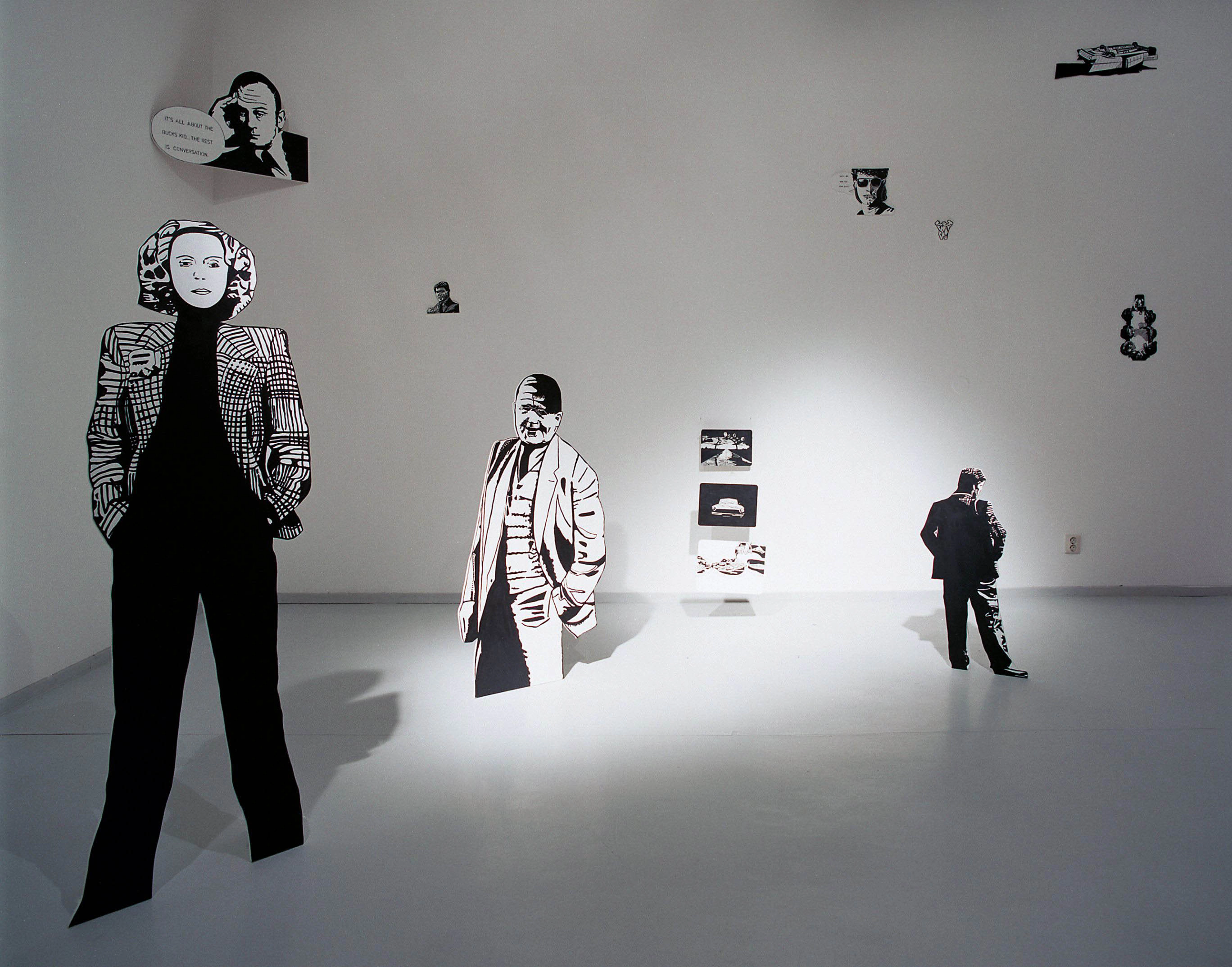
The Masterpiece, Episode Five: The Road to Ruin, 2006
installation with acrylic paint on MDF cut outs, dimensions variable
Further Reading
Olivia Plender in conversation with Kim Einarsson about the exhibition ‘Information, Education, Entertainment’, at Marabouparken, Stockholm, 2007
(download)‘I’ll Give You Television: Olivia Plender, interviewed by Robert Stasinski’, Flash Art, 2007
(read here)A Prior #19, ‘Olivia Plender: Historical Facts are as Mythic as Literary Constructs’, essay by Vanessa Desclaux, 2009
(download)